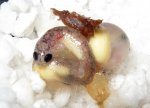They were kept separately in rubbermaid polycarbonate boxes on coarse gravel with a few large rocks and a piece of cork bark for the first 11 months in captivity. The water was chilled to ~58F and recirculated through a 5gal bucket and chiller with a powerhead, the room temp went down into the mid to upper 40s for a short period last winter. They were moved in September to a flow through system fed by a trickle of carbon filtered tap water, again polycarbonate boxes, again coarse gravel, a few large rocks, cork bark, and a few good sized wads of oak leaves. I saw courtship behavior within a week of introducing the male to the 2 females, and eggs laid about a week after that, attached to the bottom of a small cork slab on top of the damp oak leaves.
The incoming tap water temp fluctuates seasonally from a winter low of around 42F, to a summer high around 70F. Temp in the room I set manually, at the time laid there was a daytime high around 70, low around 55. She tended the eggs for a couple of weeks, but I noticed the number diminishing so I pulled them and set up on damp perlite with itraconazole in the water at 10mg/L.
Diet mainly crickets and housefly maggots, with a few earthworms.
Pretty sure other desmogs have been bred before. D. quadramaculatus and wrighti at least? I'm pretty confident I'll have true CB D. aeneus next year.
Working on the yonahlossees, I have 3 pairs at home now. Maybe next year...
-Tim

